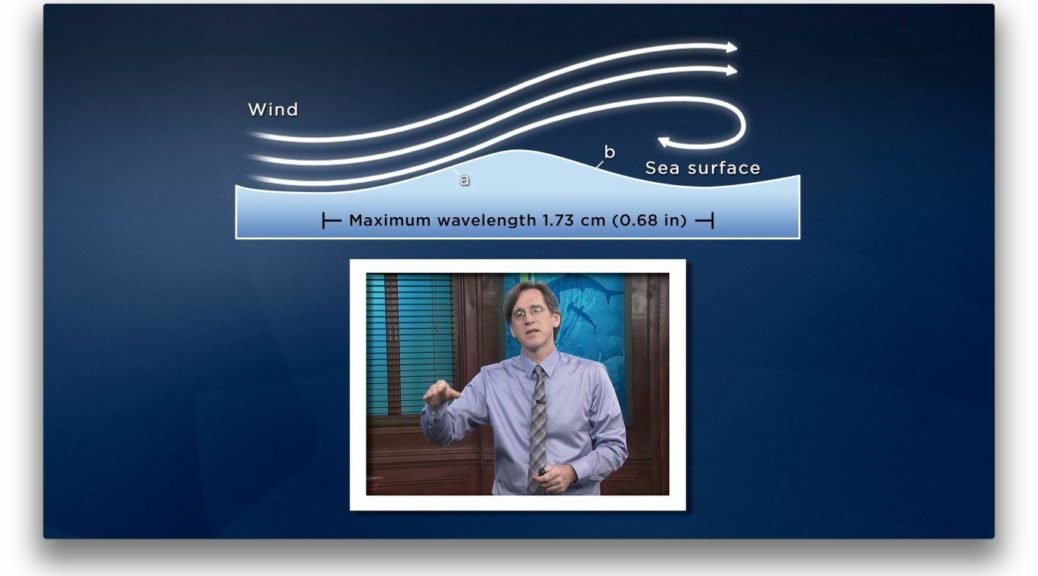
Oceanography: Exploring Earth’s Final Wilderness – The Great Courses
Oceanography: Exploring Earth’s Final Wilderness – Prof. Harold J. Tobin
I thought this would be a fun course with mostly Attenborough-esque sceneries and lots of cool info. It was way more than that. I got to learn so much and as always I’ve just taken notes of whatever stood out to me.
– Land info called maps, ocean maps called charts. Navigating with sextant and Captain cook and Darwin history.
– Bartymetry – measuring the depths of the ocean.
– 1 episode just for the Big Bang solar system formation volcanos. 90 billion year history.
– Process and history of making natural oil and gas that we use, how people drilled for it. The consequences of spills and ways to recover from it.
– Different shades of pink salt because different algeas thrive in different salinity.
– Amazing properties of water. Way more then boiling and freezing points. Changes in temperature, density, salinity and pressure in the different levels as you go deeper. Light and colour blue as you go deeper because the other colours/frequencies are not strong enough to go deeper.
– Tides are 1 third sun and 2 third moon gravitational pull.
– Springtide during full moon & new moon because sun and moon are aligned and pulling tides together.
– Tidal bores happen in narrow places where the wave builds up on itself like River Severn.
– Moon and sun are slowing down earths rotation by 2.3 milliseconds per century.
– Gasses get more soluble the colder water gets.
– Different plankton adapt their bodies in different levels to live.
– The word twilight zone originally came from oceanography.
– Jellyfish pulsing is more to sweep water to get the food from it, propulsion is just a byproduct.
– 25% of fish caught for food are thrown away because the ship is not equipped to process these types and are already dead!
– Importance of mangroves because of their roots. The trees look amazing! Kelp and mangrove forests are beautiful.
– Beach replenishment to preserve beaches from erosion. Millions are spent to put back sand on the land.
– Corals are really animals! And a 1-1.5 degree change in the water can kill them (coral bleaching).
– Sea pigs are basically water balloons and they pump water into the leg they want to move.
– El Niño comes from current of baby Christ.
– Kiribati, Tuvalu and Maldives are going to sink in a matter of decades. And the president of one of them is already vacating the inhabitants.
– There is a saying regarding sewage that goes … solution to pollution is dilution. Well its not any more!
Videos
1. Diving In – The Ocean Adventure
Begin your study of the ocean from every angle, examining Earth’s watery realm in light of geology, biology, chemistry, meteorology, and other fields. In this lecture, survey the extent of the ocean and the approaches that oceanographers take to understanding it.
2. Explorers, Navigators, Pioneering Scientists
The early explorers of the ocean were interested in charting its islands, dimensions, and resources – and in using it as a highway for trade. Relive the exploits of these mariners, who included Europeans, Chinese, and Polynesians. Only later did scientific exploration of the ocean begin.
3. Ocean Basics and Ocean Basins
As recently as the 1950s, geologists envisioned the ocean basins as a submerged version of the continents. Explore the topography of the seabed, discovering that it is shaped by geological forces fundamentally different from those on land.
4. Mapping the Sea – Soundings to Satellites
The ocean floor was once as mysterious as the surface of another planet. Investigate the technologies involved in measuring bathymetry, the undersea counterpart of topography. Weighted ropes and cables for gauging the depth of the sea have given way to sophisticated sonar from ships and radar from satellites.
5. Habitats – Sunlit Shelves to the Dark Abyss
Take a tour of organisms that live from the shallows to the ocean floor. Learn how to classify ocean zones, and discover the importance of temperature, chemistry, nutrients, light, and other factors for different life forms – from active swimmers to passive floaters and bottom dwellers.
6. The Spreading Sea Floor and Mid-Ocean Ridges
What made the ocean floor the way it is? Trace the evidence that ocean basins are geologically young and that new oceanic crust is being continually formed at mid-ocean ridges, pushing and rifting continental plates in a process called plate tectonics.
7. The Plunging Sea Floor and Deep-Sea Trenches
Investigate subduction zones, where oceanic crust plunges beneath an overriding tectonic plate. These margins are associated with deep-sea trenches, earthquakes, tsunamis, and volcanoes. Examine other features, such as hotspots, which are a mid-plate phenomenon that includes the Hawaiian Islands chain.
8. The Formation of the Earth and Its Ocean
Cover 9 billion years of cosmic history – from the big bang, to the accretion of the sun and planets, to the formation of Earth’s oceans 4 billion years ago. The water in the oceans came from water vapor in volcanic eruptions and possibly from comet impacts.
9. The Early Ocean and the Origins of Life
Explore scenarios for the origin of life, which may have begun around deep-sea hot springs. The oceans have maintained roughly the same conditions over the entire history of life on Earth, even though the sea floor has renewed itself many times over through plate tectonics.
10. Marine Sediments – Archives of the Ocean
Ocean sediments are like tree rings that can be “read” as a history of the ocean and climate through time. Investigate the different sources of sediments, which range from products of erosion on land, to the remains of sea creatures, to ejecta from asteroid impacts.
11. Offshore Oil and Gas – Resources and Risks
Learn the origin of petroleum and natural gas deposits, which formed under very specific conditions in marine sediments. As an example of the challenges of oil recovery, survey the technology of deep-water drilling, focusing on the disastrous blow-out in the Gulf of Mexico in 2010.
12. The Enduring Chemistry of Seawater
Why is the sea salty? Why isn’t it getting saltier? Probe these and other mysteries of ocean chemistry, looking at the remarkable stability and uniformity of seawater over time. Also study the role of water and the conjectured role of life in driving plate tectonics.
Amazon #ads
13. How the Physics of Water Controls the Ocean
Analyze the surprising properties that keep the ocean liquid and make water the defining physical substance for life. Among them is its ability to retain heat, which has kept Earth in a narrow temperature range hospitable to life for billions of years. Also investigate the propagation of light in water and why the ocean is blue.
14. Waves – Motion in the Ocean
Chart the dynamics of wind-generated waves, which include almost all ocean waves. See how they form, grow in size, travel for thousands of miles, and then break on shore. The big waves preferred by surfers come from remote regions that have the ocean’s stormiest weather.
15. Rogue Waves and Tsunami
Long considered a mariners’ tall tale, abnormally high “rogue” waves are now well documented. Understand the physics of why they form and the yearly toll they take on shipping. Then study tsunami, or seismic sea waves, which are generated when undersea earthquakes displace huge volumes of water, often with catastrophic results.
16. Tides in Theory and Practice
Tides are caused by the gravitational attraction of the moon and, to a lesser extent, the sun. Learn that the timing and height of tides are far more complex than the daily motions of the moon and sun suggest – due to the influences of coastal features, the Coriolis effect, and other factors.
17. Marine Life, Energy, and Food Webs
Trace the path of energy and food through oceanic ecosystems, which have a far higher turnover of biomass than the terrestrial equivalents. As a result, most of what grows in the oceans is very quickly consumed. Learn why warm, temperate seas are often nutrient-poor compared with polar waters.
18. Tiny Plankton – The Most Abundant Life on Earth
Survey some of the many species of plankton, which are passive, floating, and drifting organisms. Microscopic plankton are ubiquitous throughout the oceans and represent all three of the basic biological domains: Archaea, Bacteria, and Eukarya.
19. Soft-Bodied Life in the Dark, Open Depths
Investigate the soft-bodied organisms that live at great depths and have no skeletons or shells. Little known until recently, this group includes a variety of creatures whose amorphous bodies are often destroyed by nets and who only came to light through studies from submersibles.
20. Swimming – The Many Fish in the Sea
Contrasting with free-floating plankton, nekton are the ocean’s swimmers. In this lecture, study the most numerous nekton – fish – focusing on their streamlining, gills, schooling, and other adaptations. Also, examine mollusks, including the octopus, squid, and nautilus.
21. Marine Birds, Reptiles, and Mammals
Turn to the nekton among birds, reptiles, and mammals. These feature some of the most magnificent creatures on the planet, including albatrosses, Sooty Shearwaters, sea turtles, manatees, seals, sea lions, whales, and dolphins. Focus on the adaptations that allow them to thrive in marine environments.
22. Whaling, Fisheries, and Farming the Ocean
Examine the economic exploitation of marine life, beginning with the history of whaling and continuing to the present, when fishing is the only significant source of hunted food. Weigh the alternatives of commercial fishing and mariculture in an era of rapidly declining fish populations.
23. Where Sea Meets the Land and Why Coasts Vary
Have you ever walked along a beach or stood on a high cliff overlooking the sea and wondered how the land got to be that way? Learn how erosion, deposition, sea-level change, plate tectonics, and other factors have produced the characteristic coastlines of the world.
Amazon #ads
24. Where Rivers Meet the Sea – Estuaries and Deltas
River mouths, deltas, tidal inlets, fjords, and enclosed bays are places where freshwater and seawater mix. Explore these complex zones, which are among the most biologically productive ecosystems on Earth. Many marine organisms carry out key parts of their lifecycles in such environments.
25. Coastal Erosion – Beaches and Sea Cliffs
Coastlines are constantly changing features. Examine what happens when structures are built to halt or reverse the change, especially at a time when sea level is rising. Most human-engineered solutions turn out to be short-term at best, and many have unintended consequences.
26. Tidal Life, Sea Forests, and Coral Reefs
Begin your survey of the organisms and ecosystems that flourish in the most complex and varied part of the ocean: the benthic zone, or sea bottom. Start in the shallows, where life inhabits a wide range of niches – from the crashing waves of tide pools to placid mudflats.
27. Deep Bottom Life and Hydrothermal Vents
Continue your investigation of the benthic zone by exploring the deep ocean bottom, where astonishing diversity exists in cold, darkness, and high pressure. Your tour includes sea cucumbers, brittle stars, herds of sea pigs, and the unique community around deep sea vents, which extracts energy from the Earth itself.
28. Trade Winds – The Circulation of Heat and Wind
Explore another ocean – the ocean of air – which interacts with Earth’s seas through the force of wind on water. Investigate the cause of wind patterns such as the trade winds, westerlies, and polar easterlies. Two crucial factors are uneven distribution of heat and the Coriolis effect due to Earth’s rotation.
29. Heavy Weather – Storms and Hurricanes
Gain insight into the world’s largest storms by looking at the interaction of ocean, atmosphere, and land, and how it produces nor’easters, monsoons, and hurricanes. Focus on the life cycle of hurricanes – how they form, intensify, and often produce devastating storm surges, as happened during Hurricane Katrina.
30. The Gulf Stream to Gyres – Vast Surface Currents
Follow the chain of events that initiate surface currents in the ocean. Big currents such as the Gulf Stream are caused mainly by wind friction. The mapping of currents has been aided by incidents such as the accidental spill of thousands of floating bath toys in the Pacific in 1992.
31. Upwelling, Downwelling, and El Niño
Winds drive surface currents, and together wind and currents set in motion large-scale upwelling and downwelling. Study these patterns and the disturbances that lead to El Niño and La Niña cycles, which cause major disruptions in fisheries and weather.
32. The Deepest, Slowest River – Polar Bottom Water
While surface currents move a typical water molecule around an ocean basin in a year or two, down deep water circulates much more slowly, taking hundreds to thousands of years to make a circuit. Trace how dense, cold water masses from the polar regions slowly but inexorably move the great bulk of the ocean.
33. The Ocean and Global Climate
The ocean contains most of the heat in the ocean-atmosphere system, and surface currents distribute it around the planet. Begin your study of the ocean’s reaction to increasing carbon dioxide in the atmosphere, which is leading to climate change worldwide.
34. The Warming, Rising Sea
Learn that one conjectured effect of global warming – the shutting down of the Gulf Stream leading to a new ice age in Europe – is unlikely. But the planet is already on a path to melting glaciers and steadily rising seas, with catastrophic implications for low-lying populated areas.
35. Marine Pollution – The Impact of Toxins
Turn to the problem of marine pollution, which includes runoff from land and deliberate dumping, in addition to acidification from atmospheric carbon dioxide. Also look at the Great Pacific Garbage Patch, where plastic particles and other debris have concentrated in a rotating mid-ocean current.
36. The Future Ocean
Finish the course by looking into the future. Constant change will continue to be the state of the ocean, just as it always has been. But humans can promote change for the better in a variety of ways, including using the national park model to establish marine sanctuaries. Learn other choices you can make to help preserve this wonder of the planet.
Amazon #ads






